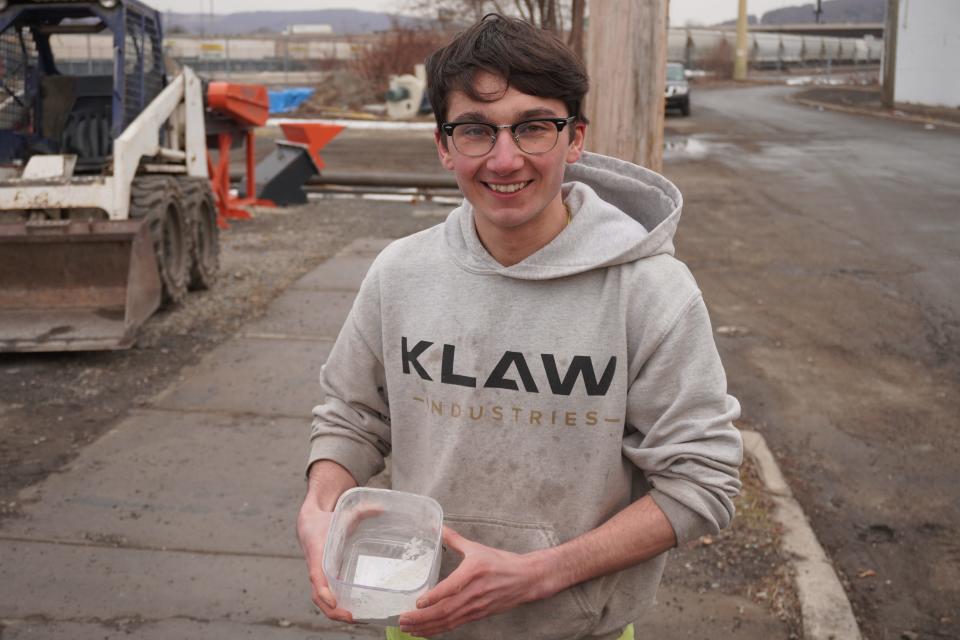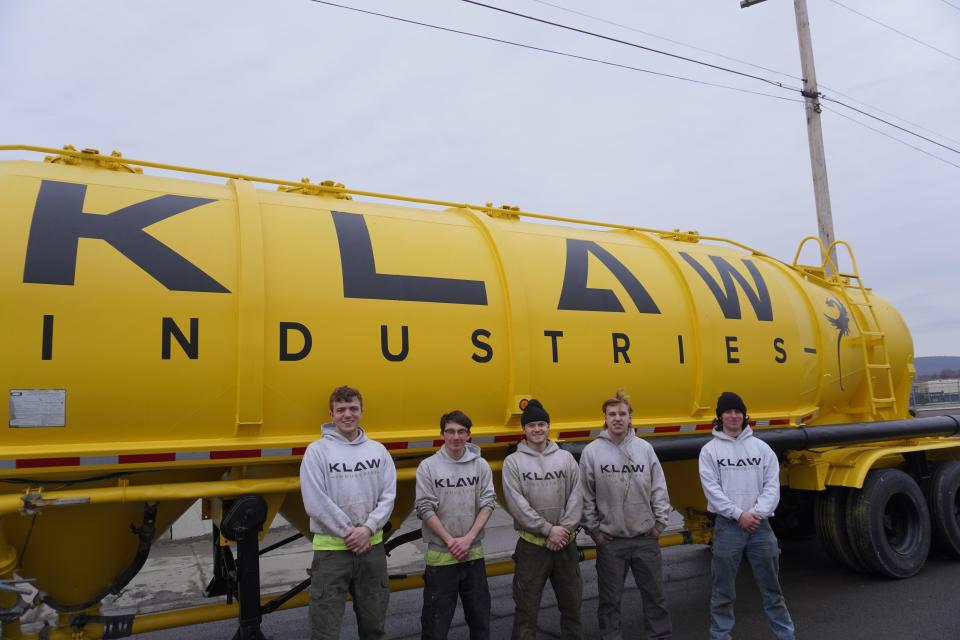With recycled glass, these Southern Tier teams are shaping the future of concrete
- Oops!Something went wrong.Please try again later.
Two Southern Tier teams are using recycled glass to lower carbon emissions in sidewalk and housing construction projects, propelling the use of "green" concrete in New York.
In September, New York Gov. Kathy Hochul announced a mandate establishing emissions limits on concrete used in state-funded public building and transportation projects, aligning with New York's commitment to reducing greenhouse gas emissions in government operations — the state is targeting a 40% reduction by 2030.
KLAW Industries, in Binghamton, and Alfred University's Center for Advanced Ceramic Technology use materials which would otherwise end up in landfills to replace about 20% of the cement used in concrete production.
KLAW's alternative mix is used in curb and sidewalk projects throughout the City of Binghamton. Alfred's CACT team, partnering with manufacturer SQ4D, plans to use their mix to create 3D-printed houses.
Mike Jagielski, director of the Clean Energy Program at Koffman Southern Tier Incubator in Binghamton, said he envisions such recycled glass products having far-reaching implications.
"We have a consumer push to eventually bring low carbon concrete to the consumer through retail outlets such as Home Depot or Lowe's," said Jagielski. "Imagine having bag concrete that is 20 percent carbon neutral — that changes the game."

Green concrete use growing in Binghamton: How it started
One of the more carbon-intensive parts of creating concrete, Jacob Kumpon, co-founder and COO of KLAW Industries, said cement manufacturing contributes to about 8% of global carbon emissions.
The idea for KLAW came from a personal interest in glass recycling.
Kumpon and his cousin, Jack Lamuraglia, who have engineering degrees from Binghamton University and Clarkson University, respectively, toured local recycling plants and discovered much of recycled glass actually ends up in landfills. Once there, companies are charged by weight, meaning getting rid of glass is an expensive process.
After looking into the concrete industry, Kumpon found there was a demand for cement replacements which, coupled with the glass industry's excess waste, presented a unique opportunity.
"We found that there is a shortage of materials to replace cement, and the prices are rising relatively quickly," said Kumpon. "It was an opportunity to connect the waste from one industry to add value to another."
Kumpon and Lamuraglia founded KLAW in 2019. Their product, dubbed Pantheon, uses recycled glass they've cleaned and ground into a fine powder to replace cement in a concrete mix. It makes the final product even stronger, Kumpon says — According to KLAW's website, it prevents 1000 pounds of carbon emissions for every cement truck used.

Already KLAW has found returning customers in the City of Binghamton and concrete supplier Barney & Dickenson, Inc., in Vestal.
"With the trend for construction materials coming under stricter regulations to reduce carbon emissions, we were excited to work with them," Barney & Dickenson's President Mary Murphy Harrison said of her first meeting with KLAW in 2019.
City of Binghamton Mayor Jared Kraham said the appeal of a cost-effective and greener product to use in local curb and sidewalk projects made the city's partnership with KLAW an easy decision.
"There is a very cool ecosystem which has developed between them and all of these local companies and local jobs they are helping support," Kraham said. "We really think that their product can be part of the future of concrete in New York and across America."
More: Binghamton U. to build lecture hall, tackle renovations with $125 million NY funding boost
Alfred University partnership uses recycled glass to 3D-print homes
Alfred University's CACT is also at the forefront of creating more sustainable cement. CACT's goal is to train students to enter the workforce, as well as produce cutting-edge research in the ceramics industry.
Through a partnership with 3D printing manufacturer SQ4D, and funding from the New York State Department of Environmental Conservation, CACT's team found a way to use green glass — the type of glass most likely to end up in landfills — as a cement replacement in their mix. With the help of Alfred University, SQ4D hopes to use the glass-based mix this summer to build 3D-printed houses.
In early March, Alfred University also announced a project in partnership the Department of Environmental Conservation (DEC) and Silica-X, a company which specializes in experimental glass. The project consists of building concrete slabs structured the same way as ancient Roman slabs and testing the durability of the material by submerging the slabs in the ocean.
According to a press release from Alfred, structures such as bridges and sea walls made with Roman concrete have withstood seawater erosion and lasted several centuries, far longer than traditional concrete. Using glass in place of other strengthening agents may help emulate Roman concrete, which could have far-reaching applications for building near water.
Collin Wilkinson, assistant professor of glass science and engineering at Alfred, said the new process could help solve the housing crisis in New York while creating significantly less waste. According to Wilkinson, SQ4D is currently working with Alfred to 3D-print a building on campus, which will occur "in the near future."
"We are really thankful for forward-thinking partners like SQ4D, who are willing to believe in the numbers," Wilkinson said, "and willing to do the science to prove this will be useful."
This article originally appeared on Binghamton Press & Sun-Bulletin: Green concrete sidewalks, 3D-printed homes: Meet NY teams behind it

